I've been using the accepted answer here for years.
On iOS 7, the contentSize.height becomes the frame.height-8, regardless of text content.
What's a working method to adjust the height on iOS 7?
I've been using the accepted answer here for years.
On iOS 7, the contentSize.height becomes the frame.height-8, regardless of text content.
What's a working method to adjust the height on iOS 7?
I favor this minimal code change: Just add these two lines after addSubview and before grabbing the height of the frame
...
[scrollView1 addSubview: myTextView];
[myTextView sizeToFit]; //added
[myTextView layoutIfNeeded]; //added
CGRect frame = myTextView.frame;
...
This is tested backwards compatible with iOS 6. NOTE that it shrink-wraps the width. If you're just interested in the height and have a fixed width, just grab the new height but set the original width, and it works just as before on both iOS 6 and 7.
(Speculation: it does size to fit on iOS 7 as well, but the layout is updated later or in a separate thread, and that this forces the layout immediately so that its frame is updated in time for using its height value a few lines later in the same thread.)
NOTES:
1) You might or might not have implemented the outer container resize this way. It does seem to be a common snippet, though, and I've used it in my projects.
2) Since sizeToFit seems to work as expected on iOS 7, you likely don't need the premature addSubView. Whether it will still work on iOS 6 then is untested by me.
3) Speculation: The extra layoutIfNeeded mid-thread might be costly. The alternative as I see it is to resize the outer container on the layout callback (fired or not depending on if the OS decides whether layout is needed or not) where the outer container resize will cause another layout update. Both updates might be combined with other layout updates to be more efficient. If you do have such a solution and you can show that it is more efficient, add it as answer and I'll be sure to mention it here.
Since I'm using Auto Layout, I use the value of [textView sizeThatFits:CGSizeMake(textView.frame.size.width, CGFLOAT_MAX)].height to update the constant of the textView's height UILayoutConstraint.
I use an adapted version of madmik's answer that eliminates the fudge factor:
- (CGFloat)measureHeightOfUITextView:(UITextView *)textView
{
if ([textView respondsToSelector:@selector(snapshotViewAfterScreenUpdates:)])
{
// This is the code for iOS 7. contentSize no longer returns the correct value, so
// we have to calculate it.
//
// This is partly borrowed from HPGrowingTextView, but I've replaced the
// magic fudge factors with the calculated values (having worked out where
// they came from)
CGRect frame = textView.bounds;
// Take account of the padding added around the text.
UIEdgeInsets textContainerInsets = textView.textContainerInset;
UIEdgeInsets contentInsets = textView.contentInset;
CGFloat leftRightPadding = textContainerInsets.left + textContainerInsets.right + textView.textContainer.lineFragmentPadding * 2 + contentInsets.left + contentInsets.right;
CGFloat topBottomPadding = textContainerInsets.top + textContainerInsets.bottom + contentInsets.top + contentInsets.bottom;
frame.size.width -= leftRightPadding;
frame.size.height -= topBottomPadding;
NSString *textToMeasure = textView.text;
if ([textToMeasure hasSuffix:@"\n"])
{
textToMeasure = [NSString stringWithFormat:@"%@-", textView.text];
}
// NSString class method: boundingRectWithSize:options:attributes:context is
// available only on ios7.0 sdk.
NSMutableParagraphStyle *paragraphStyle = [[NSMutableParagraphStyle alloc] init];
[paragraphStyle setLineBreakMode:NSLineBreakByWordWrapping];
NSDictionary *attributes = @{ NSFontAttributeName: textView.font, NSParagraphStyleAttributeName : paragraphStyle };
CGRect size = [textToMeasure boundingRectWithSize:CGSizeMake(CGRectGetWidth(frame), MAXFLOAT)
options:NSStringDrawingUsesLineFragmentOrigin
attributes:attributes
context:nil];
CGFloat measuredHeight = ceilf(CGRectGetHeight(size) + topBottomPadding);
return measuredHeight;
}
else
{
return textView.contentSize.height;
}
}
Based on other answers, I made it work(in Swift). This solves the problem with newline character.
textView.sizeToFit()
textView.layoutIfNeeded()
let height = textView.sizeThatFits(CGSizeMake(textView.frame.size.width, CGFloat.max)).height
textView.contentSize.height = height
Auto Layout is needed.
If you're using Auto Layout, you could create a trivial UITextView subclass that self-sizes the text view height to fit the content:
@interface ContentHeightTextView : UITextView
@end
@interface ContentHeightTextView ()
@property (nonatomic, strong) NSLayoutConstraint *heightConstraint;
@end
@implementation ContentHeightTextView
- (void)layoutSubviews
{
[super layoutSubviews];
CGSize size = [self sizeThatFits:CGSizeMake(self.bounds.size.width, FLT_MAX)];
if (!self.heightConstraint) {
self.heightConstraint = [NSLayoutConstraint constraintWithItem:self attribute:NSLayoutAttributeHeight relatedBy:NSLayoutRelationEqual toItem:nil attribute:0 multiplier:1.0f constant:size.height];
[self addConstraint:self.heightConstraint];
}
self.heightConstraint.constant = size.height;
[super layoutSubviews];
}
@end
Of course, the text view's width and position must be defined by additional constraints configured elsewhere in the program.
If you create this custom text view in IB, give the text view a height constraint in order to satisfy Xcode; just make sure the height constraint created in IB is merely a placeholder (i.e., tick the box that says "Remove at build time").

An alternative way to implement the UITextView subclass is as follows (this implementation might qualify as best practice):
@interface ContentHeightTextView ()
@property (nonatomic, strong) NSLayoutConstraint *heightConstraint;
@end
@implementation ContentHeightTextView
- (void)layoutSubviews
{
[super layoutSubviews];
[self setNeedsUpdateConstraints];
}
- (void)updateConstraints
{
CGSize size = [self sizeThatFits:CGSizeMake(self.bounds.size.width, FLT_MAX)];
if (!self.heightConstraint) {
self.heightConstraint = [NSLayoutConstraint constraintWithItem:self attribute:NSLayoutAttributeHeight relatedBy:NSLayoutRelationEqual toItem:nil attribute:0 multiplier:1.0f constant:size.height];
[self addConstraint:self.heightConstraint];
}
self.heightConstraint.constant = size.height;
[super updateConstraints];
}
@end
If you are using auto-layout, you can use the following UITextView subclass that adds an intrinsic height:
@implementation SelfSizingTextView
- (void)setText:(NSString *)text
{
[super setText:text];
[self invalidateIntrinsicContentSize];
}
- (void)setFont:(UIFont *)font
{
[super setFont:font];
[self invalidateIntrinsicContentSize];
}
- (CGSize)intrinsicContentSize
{
CGFloat width = self.frame.size.width;
CGSize size = [self sizeThatFits:CGSizeMake(width, MAXFLOAT)];
return CGSizeMake(UIViewNoIntrinsicMetric, size.height);
}
@end
this method seems to work.
// Code from apple developer forum - @Steve Krulewitz, @Mark Marszal, @Eric Silverberg
- (CGFloat)measureHeight
{
if ([self respondsToSelector:@selector(snapshotViewAfterScreenUpdates:)])
{
CGRect frame = internalTextView.bounds;
CGSize fudgeFactor;
// The padding added around the text on iOS6 and iOS7 is different.
fudgeFactor = CGSizeMake(10.0, 16.0);
frame.size.height -= fudgeFactor.height;
frame.size.width -= fudgeFactor.width;
NSMutableAttributedString* textToMeasure;
if(internalTextView.attributedText && internalTextView.attributedText.length > 0){
textToMeasure = [[NSMutableAttributedString alloc] initWithAttributedString:internalTextView.attributedText];
}
else{
textToMeasure = [[NSMutableAttributedString alloc] initWithString:internalTextView.text];
[textToMeasure addAttribute:NSFontAttributeName value:internalTextView.font range:NSMakeRange(0, textToMeasure.length)];
}
if ([textToMeasure.string hasSuffix:@"\n"])
{
[textToMeasure appendAttributedString:[[NSAttributedString alloc] initWithString:@"-" attributes:@{NSFontAttributeName: internalTextView.font}]];
}
// NSAttributedString class method: boundingRectWithSize:options:context is
// available only on ios7.0 sdk.
CGRect size = [textToMeasure boundingRectWithSize:CGSizeMake(CGRectGetWidth(frame), MAXFLOAT)
options:NSStringDrawingUsesLineFragmentOrigin
context:nil];
return CGRectGetHeight(size) + fudgeFactor.height;
}
else
{
return self.internalTextView.contentSize.height;
}
}
If you're using iOS 7+, you can just turn on auto layout, pin each of the sides of the text view to the edge of its parent view, and it works fine. No additional code needed.
Not sure if this was always the case but the following is true since at least iOS 10.
UITextView implements the intrinsicContentSize property if scrollEnabled == NO. That means you just need to make sure the width of the text view is constrained enough and then you can use the intrinsic content height (either via Auto Layout content hugging/compression resistance priorities or directly using the value during manual layout).
Unfortunately, this behavior is not documented. Apple could have easily saved us all some headaches… no need for an extra height constraint, subclassing, etc.
In iOS 8 you'll in inherit some content offset from the parent, which you need to get rid of as well.
A subclass example
// Originally from https://github.com/Nikita2k/resizableTextView
#import "ResizableTextView.h"
@implementation ResizableTextView
- (void) updateConstraints {
// calculate contentSize manually
// ios7 doesn't calculate it before viewDidAppear and we'll get here before
CGSize contentSize = [self sizeThatFits:CGSizeMake(self.frame.size.width, FLT_MAX)];
// set the height constraint to change textView height
[self.constraints enumerateObjectsUsingBlock:^(NSLayoutConstraint *constraint, NSUInteger idx, BOOL *stop) {
if (constraint.firstAttribute == NSLayoutAttributeHeight) {
constraint.constant = contentSize.height;
*stop = YES;
}
}];
[super updateConstraints];
}
- (void)setContentOffset:(CGPoint)contentOffset
{
// In iOS 8 we seem to be inheriting the content offset from the parent.
// I'm not interested
}
@end
In storyboard, if using constraints, make sure you are constrained to your superview in the 'ruler' tab of the right-hand pane on xcode for the UITextView. My problem was that I had a constraint of -80 pts on the 'Trailing space to'.

Guys using autolayout and your sizetofit isn't working, then please check your width constraint once. If you had missed the width constraint then the height will be accurate.
No need to use any other API. just one line would fix all the issue.
[_textView sizeToFit];
Here, I was only concerned with height, keeping the width fixed and had missed the width constraint of my TextView in storyboard.
And this was to show up the dynamic content from the services.
Hope this might help..
I wrote a category over UITextView:
- (CGSize)intrinsicContentSize {
return self.contentSize;
}
- (void)setContentSize:(CGSize)contentSize {
[super setContentSize:contentSize];
[self invalidateIntrinsicContentSize];
}
When UIKit sets its contentSize, UITextView adjusts its intrinsic content size. That plays nicely with autolayout.
The answer given by bilobatum worked perfectly With auto layout, i.e subclassing the textview.
If you want to limit the height of the text view add another constraint (I added it using storyboard i.e. height <= 166 (height as per your need))
Then inside subclass reduce the priority of height constraint to 750 (self.heightConstraint.priority = 750) to avoid conflict between height constraint added in subclass and height constraint added on storyboard.